The BMD-4 for Boyevaya Mashina Desanta-4 or "Combat Vehicle of the Airborne" is so far the latest infantry fighting vehicle of the Russian airborne (VDV), planned to succeed to the BMD-3 in service since 1990. It was originally designated BMD-3M as based on the same chassis, however so many modifications were made to the turret, that its capabilities were augmented (notably with a new hunter-killer capability, better sights, etc.). So far, c300 has been built, with the objective of equipping 11 batallions of the VDV with 31 of these each (341) plus spares by 2023. An APC and several specialized vehicles has been derived. The BMD-4 sees service in the current war in Ukraine.
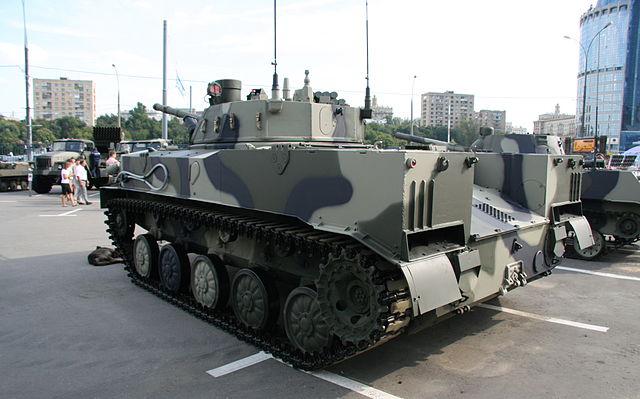
Rear of the BMD-4M
Many components, ergonomics, crew positions a copy-paste of the BMD-3, to avoid retraining crews. Primary differences are with the armament, judged adequate but relatively complicated to operate on the BMD-3. She is fitted with the new Bakhcha-U turret, composed of a lighter 100 mm 2A70 low-pressure rifled gun coupled to the same 30 mm 2A72 coaxial autocannon, and 7.62 mm PKT coaxial machine gun, still a very potent combination. The 2A70 fires HR-Frag rounds plus laser-guided ATGMs for extra punch. The two others are usable to deal with infantry and lighter armored fighting vehicles. All is managed b a brad new automated fire control system, quite advanced to automatize and simplify the gunner and commander's tasks in combat.
The BMD-4 was designed by the Volgograd tractor factory. The armament was developed by KBP Instrument Design Bureau in Tula. Kurganmashzavod was the final assembler/manufacturer. The BMD-4 entered service in late 2004 after a long trials gestation, with production going on since at low pace. In 2008 the BMD-4M was introduced by Kurganmashzavod, with considerable improvements (see later).
On March 21, 2008, Kurganmashzavod unveiled the BMD-4M after the bankruptcy of the venerable Volgograd tractor factory. That year, testing of a modernized BMD-4 approved by the Chief Armor Management of the MoD and VDV and these tests being proved successful, mass production was planned to start late in 2009. But it was postponed along with the 2S25 Sprut-SD, at least until August 2012, when in a public declaration Alexander Sukhorukov (former deputy of the Defense Minister) admitted the BMD-4M failed to meet the new requirements of the Russian military, and so further purchases has been cancelled. This was moderated by the producion boss, Vladimir Shamanov which started the 4M was fully compliant with the VDV, but decision was suspended to Supreme Commander, Vladimir Putin. Meanwhile, production resumed and another batch of the BMD-4M was received in units by mid-2014. The first eight were delivered to the 106th Guards Airborne Assault Division at Kurganmashzavod, for intensive testing.
It seems at the end of these they succeed all expectations, being operational in the most extreme climatic conditions and were airdropped without issue, as well as water-tested even at sea. The test commission recommended its use by the VDV as a result and Maj. Gen. Andrei Kholzakov (Dept. Cdr of VDV) declared it ready for service by January 15, 2015.He added that an important variant, the BTR-MD Rakushka APC based on the same vehicle also concluded successfully its tests by 2014. Thus, they were officially pressed into service by April 2016.
The BMD-4 is fully amphibious, fitted two water jets at the back which can be oriented through cables. The BMD-4 can swim even on lakes or sea but at a Beaufort scale of 2. The trim vane is erected and bilge pimps activated, whilet he driver activates the propeller drive. It has a power-to-weight ratio seemingly better than the BMD-3 for better accelerations. The vehicle was tested capable of climbing a 60° gradient, 35° side slope, gap a 1.8 m trench, climb a 0.8 m obstacle. Its hydropneumatic suspension enable precise adjustments to the ground with a clearing ranging from 130–530 mm and a normal road clearance of 450 mm as setup by the driver with a full motion from min to max in 10 seconds. This features also allows it to "lay down" in observation mode, helped by its low profile already.
For tactical deployment, the BMD-4 is designed to be strapped on a wooden plate, parachuting from a heavy duty model such as the Ll 76, and be airdropped with the entire crew and passengers aboard, allowing quick engagement after automatic release of all straps. Each Ll 76 can carry two of these, versus three BMD-1/BMD-2s.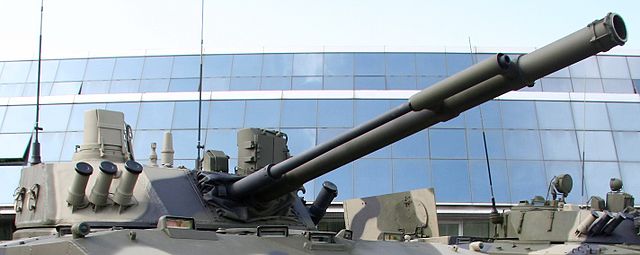
Turret closeup.
The 2A70 rifled gun fired shells of the ready-to-use HE-Frag model (34 stored in the turret), fitted with an autoloader due to the lack of space, and firing at 10-12 rounds per minute, reaching loading reduced to 5–6 seconds. The HE-Frag is either a 3UOF17 or 3UOF19 with muzzle velocities of 250 and 355 m/s respectively, the latter using a larger proximity detonation fuse perfect to deal with infantry formations. Max range is circa 7 km.
The second asset is the new 9M117M1 Arkan anti-tank guided missile (ATGM), a further development of the 9M117 Bastion (NATO AT-10 Stabber) of the BMD-3, and a real improvements. Tube-fired, it weights 21.5 kg, but has a tandem charge giving it a penetration value of 750–800 mm RHA, behind ERA. Onlu four of these are carried. Capable of 300 m/s is is laser-guided wih a 5.5 km range.
Second is the RPK-74 hull bow, right side MG acivated by the driver. Its range is 800 m, firing lighter Kalashnikov type (5.45 × 39mm) rounds. Curcially it can be dismounted for ground support.
Last but not least, the BMD-4 anti-tank capabilities can be extended by mounting a 9P135M launcher post on the roof, also dismountable. It fires the wire guided "Fagot" ATGM (NATO AT-4 Spigot) and Konkurs (NATO AT-5 Spandrel). The first is short range (2 km) and flies at 186 m/s, making it still capable of defeating 480 mm of RHA. The Fagot-M is capable of 2.5 km for 550 mm penetration, whereas the Konkurs is capable of 4km at 206 m/s, penetrating up to 750–800 mm RHA and Konkurs-M 750–800 mm post-ERA by using a tandem warhead. Night vision reduces the range down to 2500 m.
The gunner's sight is about the same but offers a single view, but it is combined with a visual imaging, thermal imaging and range-finding channels, as well as missile guidance channel. This combination makes the BMD-4 the first VDV hunter-killer capable combat vehicle; Thus also enables the gunner to use the commander's sight to engage targets if loosing his own. The commander can also override the gunner, to take control of the turret. Both has full control in the end.
BMD-4M: Modular unification with the BMP-3.
BMD-4M Sinitsa: Further modular unification with the BMP-3, and its Sinitsa turret.
BTR-MDM Rakushka: Armored personnel carrier (3 crew, 12 troops).
2S25 Sprut-SD: tank destroyer with 2A75 anti-tank gun, featuring a longer chassis among others.
2S42 Lotos: Self-propelled 120 mm mortar (based BMD-4M) and 2S25*.
Ptitselov: Self-propelled airdroppable SAM system (12 9M337 missiles)**.
Self-propelled airdroppable 9P163 Kornet-D1 ATGM system (Project)
The first production models, 12 BMD-4M and 12 BTR-MDM "Rakushka" were transferred to the Russian Airborne Troops (VDV) officially on March 3, 2015. The MoD plans for the delivery of 250 BMD-4M and BTR-MDM Rakushka over three years as contracted, 33 delivered in the spring of 2016 and 31 BMD-4Ms and 12 BTR-MDMs by the fall of 2016, 60 BMD-4Ms and BTR-MDMs total. 10 BMD-4M and 15 BTR-MDM were delivered in early 2017, 50 BMD-4Ms and BTR-MDMs by April 50 more in August and another batch in 2018.
A new contract was signed with the Shipunov Design Bureau have for delivering 190 BMD-4M and BTR-MDM Rakushka between 2018 and 2020, 132 BMD-4M and 58 BTR-MDM Rakushka before 2020. 31 BMD-4Ms and 8 BTR-MDMs arrived by March 2019 and 42 BMD-4M by July 2019. Last unit equipped in 2020 was the Pskov paratroopers (31 BMD-4M, 8 BTR-MDM Rakushka) in January and more in 2020 and 2021, then another batch in 2022. It is estimated the total is now (summer 2023) about 300 vehicles.
Being a recent addition, the only combat seen by the BMD-4 so far has been in Ukraine in 2022. Oryx Spioenkop states 85 BTR-4M has been lost in action so far, with as much as 11 captured. One interestingly hosted a RP337VM1 jammer. 22 BTR-MDM has been also lost.
The last Airborne IFV

Rear of the BMD-4M
Many components, ergonomics, crew positions a copy-paste of the BMD-3, to avoid retraining crews. Primary differences are with the armament, judged adequate but relatively complicated to operate on the BMD-3. She is fitted with the new Bakhcha-U turret, composed of a lighter 100 mm 2A70 low-pressure rifled gun coupled to the same 30 mm 2A72 coaxial autocannon, and 7.62 mm PKT coaxial machine gun, still a very potent combination. The 2A70 fires HR-Frag rounds plus laser-guided ATGMs for extra punch. The two others are usable to deal with infantry and lighter armored fighting vehicles. All is managed b a brad new automated fire control system, quite advanced to automatize and simplify the gunner and commander's tasks in combat.
The BMD-4 was designed by the Volgograd tractor factory. The armament was developed by KBP Instrument Design Bureau in Tula. Kurganmashzavod was the final assembler/manufacturer. The BMD-4 entered service in late 2004 after a long trials gestation, with production going on since at low pace. In 2008 the BMD-4M was introduced by Kurganmashzavod, with considerable improvements (see later).
Development and evolution
The BMD-4 was eventually adopted by the Russian Armed Forces on December 31, 2004 and by August the next year, the 106th Guards Airborne Division touched the first batch for in conditions tests, whereas the company declared a new batch of 60 vehicles would be ready soon. By 2010 however, the order was cancelled, concerning those with the "Bakhcha-U" turret, along with the 2S25. VDV commander Vladimir Shamanov indeed stated that the BMD-4 was unreliable and so the modernized BMD-4M, just tested, was more sucessful for a production.On March 21, 2008, Kurganmashzavod unveiled the BMD-4M after the bankruptcy of the venerable Volgograd tractor factory. That year, testing of a modernized BMD-4 approved by the Chief Armor Management of the MoD and VDV and these tests being proved successful, mass production was planned to start late in 2009. But it was postponed along with the 2S25 Sprut-SD, at least until August 2012, when in a public declaration Alexander Sukhorukov (former deputy of the Defense Minister) admitted the BMD-4M failed to meet the new requirements of the Russian military, and so further purchases has been cancelled. This was moderated by the producion boss, Vladimir Shamanov which started the 4M was fully compliant with the VDV, but decision was suspended to Supreme Commander, Vladimir Putin. Meanwhile, production resumed and another batch of the BMD-4M was received in units by mid-2014. The first eight were delivered to the 106th Guards Airborne Assault Division at Kurganmashzavod, for intensive testing.
It seems at the end of these they succeed all expectations, being operational in the most extreme climatic conditions and were airdropped without issue, as well as water-tested even at sea. The test commission recommended its use by the VDV as a result and Maj. Gen. Andrei Kholzakov (Dept. Cdr of VDV) declared it ready for service by January 15, 2015.He added that an important variant, the BTR-MD Rakushka APC based on the same vehicle also concluded successfully its tests by 2014. Thus, they were officially pressed into service by April 2016.
Design of the class
Hull and general design
The hull of the BMD-4 is strongly resminiscent of the BMD-3 with a 3-man crew (vehicle commander, gunner, driver) and up to five infantry seated aft. Ergonomics were reworked and the vehicle was overall more spacious, and certainly more than the BMD-2.Armour protection layout
The BMD-4 was heavier than the BMD-3 (13.6 vs 12,9 t) while using an aluminum alloy for the hull ensuring protection of the forntal arc from 30 mm rounds, but only small arms fire and shrapnel all around. Part of the protection counted on the addition of the sharp angle of the nose combined with the additional trim vane. Due to this slope angle, experts estimates the forward aliminium plating is around 18-20 mm. The BMD-4 like its predecessor is NBC protected, with sealings, overpressure, air conditioning, and Halon automatic fire suppression systems in the main and engine compartments. The interrio is also covered by a spall liner to avoid splinters. As for active protection and infrared orddnance, the turret carries six 81 mm ZD6 smoke grenade dischargers (two banks of three mounted either sides of the turret). There is no laser beam detector however, nor illumination system.Powerplant
Suspension was the same as the BMD-3, with six small road wheels, four track rollers per side, automatic transmission, five gears for forward and five backwards. The engine is not new, it is the 2V-06-2, same as the BMD-3 with minor improvements. It is rated for 450 horsepower, enabling a top speed of 67 km/h on flat, 45 km/h off road, 10 km/h when swimming, and a consumption of 160 g/h.p.h, 500 km range overall at cruise speed. The BMF-3 was lighter and thus faster at 71 kph and up to 50 off-road with a better ration of 34,9 hp/t.The BMD-4 is fully amphibious, fitted two water jets at the back which can be oriented through cables. The BMD-4 can swim even on lakes or sea but at a Beaufort scale of 2. The trim vane is erected and bilge pimps activated, whilet he driver activates the propeller drive. It has a power-to-weight ratio seemingly better than the BMD-3 for better accelerations. The vehicle was tested capable of climbing a 60° gradient, 35° side slope, gap a 1.8 m trench, climb a 0.8 m obstacle. Its hydropneumatic suspension enable precise adjustments to the ground with a clearing ranging from 130–530 mm and a normal road clearance of 450 mm as setup by the driver with a full motion from min to max in 10 seconds. This features also allows it to "lay down" in observation mode, helped by its low profile already.
For tactical deployment, the BMD-4 is designed to be strapped on a wooden plate, parachuting from a heavy duty model such as the Ll 76, and be airdropped with the entire crew and passengers aboard, allowing quick engagement after automatic release of all straps. Each Ll 76 can carry two of these, versus three BMD-1/BMD-2s.
Armament

Turret closeup.
Main
The BMD-4 Primary armament is housed in the small Bakhcha-U ("Melon field") turret, comprising a very dense ordnance grouping, between the low pressure 100 mm 2A70 rifled gun, coaxial 30 mm 2A72 autocannon, and coaxial 7.62 mm PKT machine gun. Designed by the KBP Instrument Design Bureau it enables a wide range of answers to any threat for such a light vehicle, without heavier support. The BMD-4 is thus capable of answering attacks from main battle tanks, lighter IFVs, as well as helicopters to some extant with the autocannon, raising artificially the nose using the suspension. The Bakhcha-U turret was also designed to be installed on the turret rings of the BMP-2, BMP-3, and BTR-90. It allows a quite 360° traverse, maximum elevation of 60° for the main gun block (all three are soldirary due to the limited space). Maximum depression is −6° but both could be augmented by using hysdrstatic differenncial.The 2A70 rifled gun fired shells of the ready-to-use HE-Frag model (34 stored in the turret), fitted with an autoloader due to the lack of space, and firing at 10-12 rounds per minute, reaching loading reduced to 5–6 seconds. The HE-Frag is either a 3UOF17 or 3UOF19 with muzzle velocities of 250 and 355 m/s respectively, the latter using a larger proximity detonation fuse perfect to deal with infantry formations. Max range is circa 7 km.
The second asset is the new 9M117M1 Arkan anti-tank guided missile (ATGM), a further development of the 9M117 Bastion (NATO AT-10 Stabber) of the BMD-3, and a real improvements. Tube-fired, it weights 21.5 kg, but has a tandem charge giving it a penetration value of 750–800 mm RHA, behind ERA. Onlu four of these are carried. Capable of 300 m/s is is laser-guided wih a 5.5 km range.
Secondary
Next to the main gun is located the 30 mm 2A72 autocannon, coaxial, with 500 rounds, 245 HE, and 255 armor-piercing discarding sabot (APCR). Muzzle velocity is 1120 m/s, cyclic rate of fire 350–400 rds/min. The AP shell has been tested able to penetrate 22 mm RHA at 60° angle from 2000 m. To avoid gas contamination, there is a delayed unlocking in the recoil action to have forward case ejection.Tertiary
Next on the same mount is the independent coasial 7.62 mm PKT machine gun with 2000 rounds carried in the turret combined into a single belt, thus eliminating reloading. There are tracers included every ten bullets for aiming.Second is the RPK-74 hull bow, right side MG acivated by the driver. Its range is 800 m, firing lighter Kalashnikov type (5.45 × 39mm) rounds. Curcially it can be dismounted for ground support.
Last but not least, the BMD-4 anti-tank capabilities can be extended by mounting a 9P135M launcher post on the roof, also dismountable. It fires the wire guided "Fagot" ATGM (NATO AT-4 Spigot) and Konkurs (NATO AT-5 Spandrel). The first is short range (2 km) and flies at 186 m/s, making it still capable of defeating 480 mm of RHA. The Fagot-M is capable of 2.5 km for 550 mm penetration, whereas the Konkurs is capable of 4km at 206 m/s, penetrating up to 750–800 mm RHA and Konkurs-M 750–800 mm post-ERA by using a tandem warhead. Night vision reduces the range down to 2500 m.
Fire Control
The commander's station features an advanced fire control system proper to the new Bakhcha-U turret, capable to fire all armaments effectively regardless of the speed or meteorological condition day and night, swimming on on the ground due to its 3D stabilization system. Advanced ballistic calculations enabled quick setup in order to also deal with incoming helicopters. This system is automated by day and night. It is completed by two advanced optical sights (commander and gunner) while the first has a panoramic or 360° sight made to search for targets. It has thermal imaging, range finding channels up to 10 km.The gunner's sight is about the same but offers a single view, but it is combined with a visual imaging, thermal imaging and range-finding channels, as well as missile guidance channel. This combination makes the BMD-4 the first VDV hunter-killer capable combat vehicle; Thus also enables the gunner to use the commander's sight to engage targets if loosing his own. The commander can also override the gunner, to take control of the turret. Both has full control in the end.
Variants and Derivatives
Variants
BMD-4K: Commander variant (additional radio station).BMD-4M: Modular unification with the BMP-3.
BMD-4M Sinitsa: Further modular unification with the BMP-3, and its Sinitsa turret.
BTR-MDM Rakushka: Armored personnel carrier (3 crew, 12 troops).
2S25 Sprut-SD: tank destroyer with 2A75 anti-tank gun, featuring a longer chassis among others.
2S42 Lotos: Self-propelled 120 mm mortar (based BMD-4M) and 2S25*.
Ptitselov: Self-propelled airdroppable SAM system (12 9M337 missiles)**.
Self-propelled airdroppable 9P163 Kornet-D1 ATGM system (Project)
Derivatives
BMD-4M (2008)
The BMD-4M retains the Bakhcha-U turret with a better overall bulletproof crew protection, new lightweight/durable alloys and 80% unification of systems with the BMP-3 for lower airborne servicing and maintenance costs.BMD-4M Sinitsa (2017)
The BMD-4M Sinitsa uses a new turret combat module fitted with a top-mounted panoramic sight, thermal imaging channel, 100 mm 2A70 tank gun/ATGM launcher, 30 mm 2A72 autocannon and 7.62mm PKMS medium machine gun while the rest of the chassis is common wit the BMP-3 for extra standardization.Kornet-D1 BMGSh (2019)
Announced by January 2019, state trials of the 9P163 Kornet-D1 system as an antitank variant of BMD-4M chassis started. It reused part of the BTR-MDM Rakushka APC hull, modified to carry internally two telescopic launchers (four ATGM each) plus eight (or more) reloads inside. So far it's a project, no photos exists.The BMD-4 in service
Russian airborne troops were to received eleven 'Battalion kits' with the vehicle, each counting 31 BMD-4M and 16 BTR-MDM to carry extra paratroops, plus a small amount as per the training units, first 17 BMD-4Ms and 12 BTR-MDMs delivered in 2015 to the Ryazan Airborne Command School and ten BMD-4M received the 242nd Airborne Training Center in Omsk.The first production models, 12 BMD-4M and 12 BTR-MDM "Rakushka" were transferred to the Russian Airborne Troops (VDV) officially on March 3, 2015. The MoD plans for the delivery of 250 BMD-4M and BTR-MDM Rakushka over three years as contracted, 33 delivered in the spring of 2016 and 31 BMD-4Ms and 12 BTR-MDMs by the fall of 2016, 60 BMD-4Ms and BTR-MDMs total. 10 BMD-4M and 15 BTR-MDM were delivered in early 2017, 50 BMD-4Ms and BTR-MDMs by April 50 more in August and another batch in 2018.
A new contract was signed with the Shipunov Design Bureau have for delivering 190 BMD-4M and BTR-MDM Rakushka between 2018 and 2020, 132 BMD-4M and 58 BTR-MDM Rakushka before 2020. 31 BMD-4Ms and 8 BTR-MDMs arrived by March 2019 and 42 BMD-4M by July 2019. Last unit equipped in 2020 was the Pskov paratroopers (31 BMD-4M, 8 BTR-MDM Rakushka) in January and more in 2020 and 2021, then another batch in 2022. It is estimated the total is now (summer 2023) about 300 vehicles.
Being a recent addition, the only combat seen by the BMD-4 so far has been in Ukraine in 2022. Oryx Spioenkop states 85 BTR-4M has been lost in action so far, with as much as 11 captured. One interestingly hosted a RP337VM1 jammer. 22 BTR-MDM has been also lost.
specifications (BMD-4) | |
| Total weight, battle ready | 13.6 t (15.0 short tons; 13.4 long tons) |
| Dimensions (L-w-h) | 6.36 x 3.11 x 2.45m (20 ft 10 in oa x 10 ft 2 in x 8 ft) |
| Crew | 3+5 infantry |
| Propulsion | 2V-06-2 water-cooled diesel engine 450 hp (331 kW) 33.1 hp/t |
| Speed (land/off-road/water) | Hydropneumatic suspension, 70/45/10 km/h |
| Range (on flat) | 500 km (310 mi) (flat) |
| Armament | 100 mm 2A70, 30 mm 2A72, 9M113 Konkurs ATGM, 5.45 mm RPK-74, 7.62 mm PKM |
| Armor | Steel turret, aliminium alloy |
| Total production | c300 so far |
Illustrations
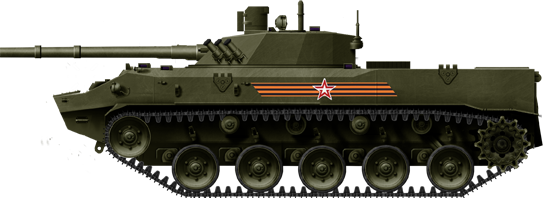
BMD-4 early vehicle at the 2005 May parade
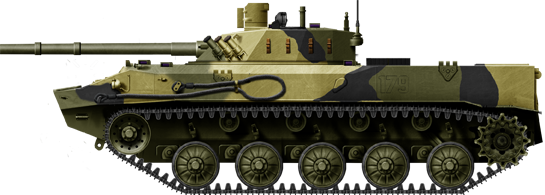
Serial VDV 4M, camouflaged
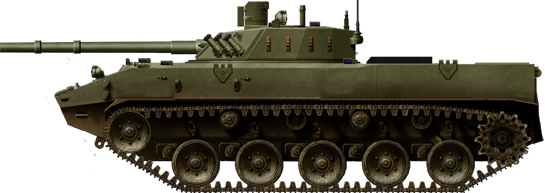
Serial BMD-4M
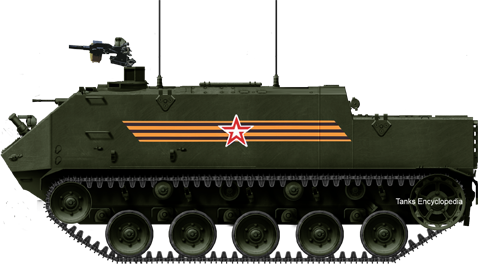
BTR-MD
Gallery
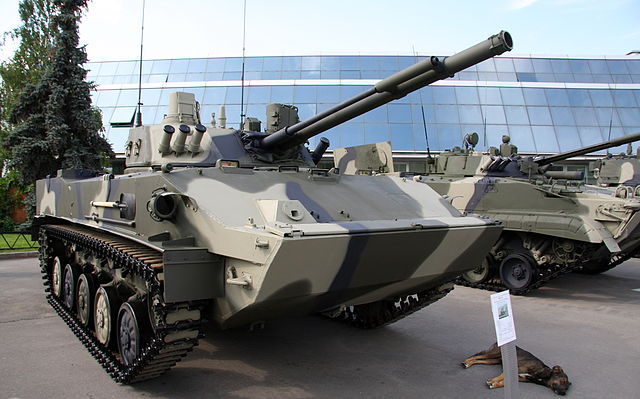
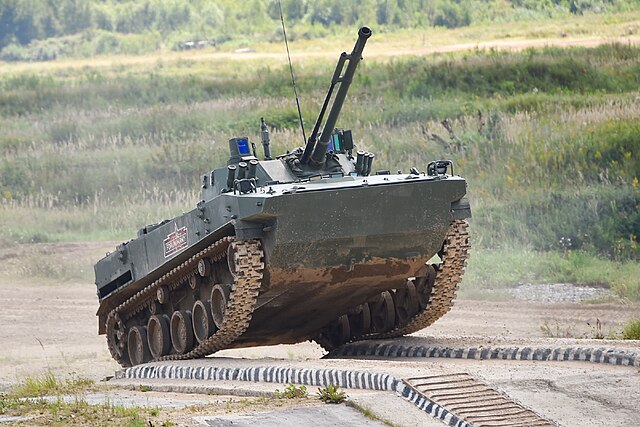

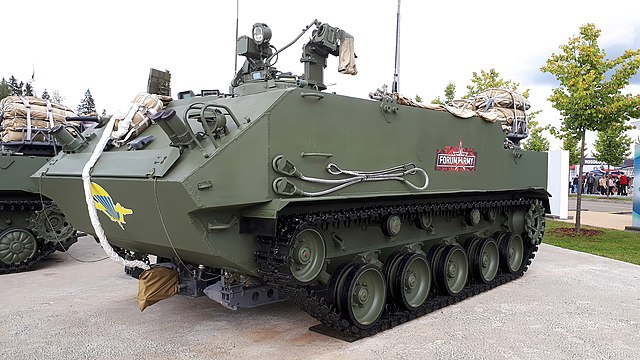
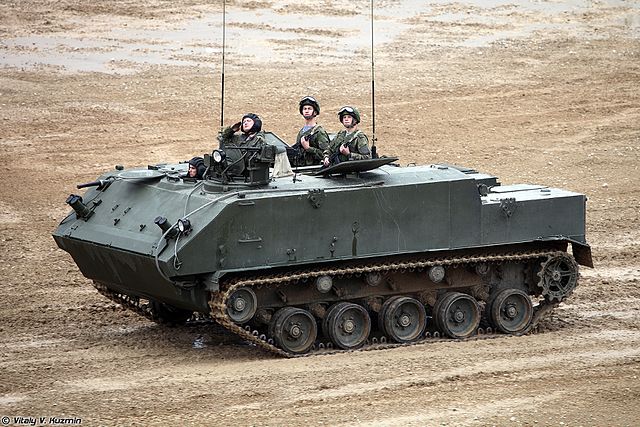
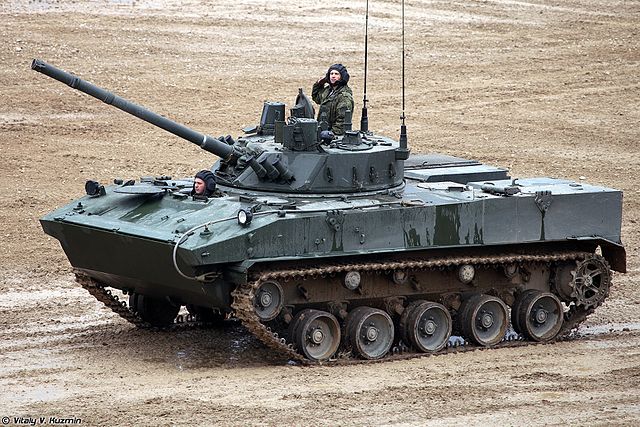
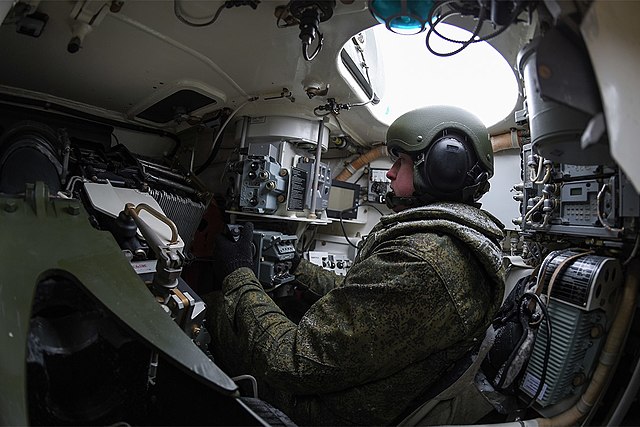
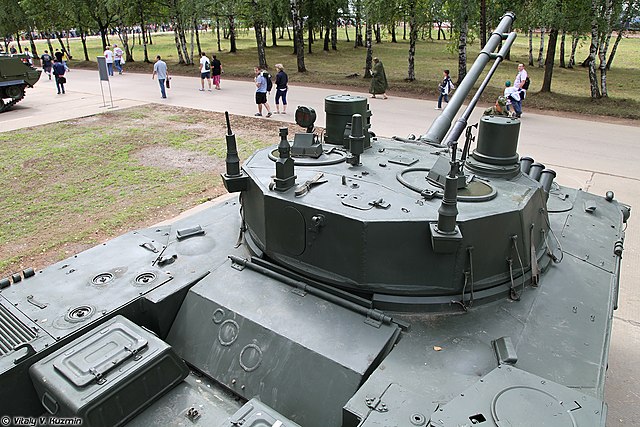
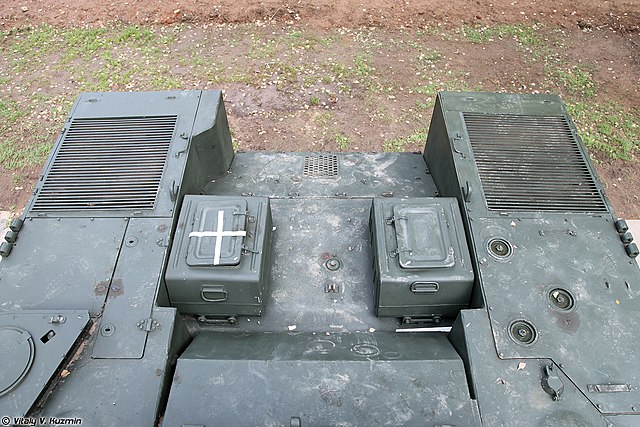
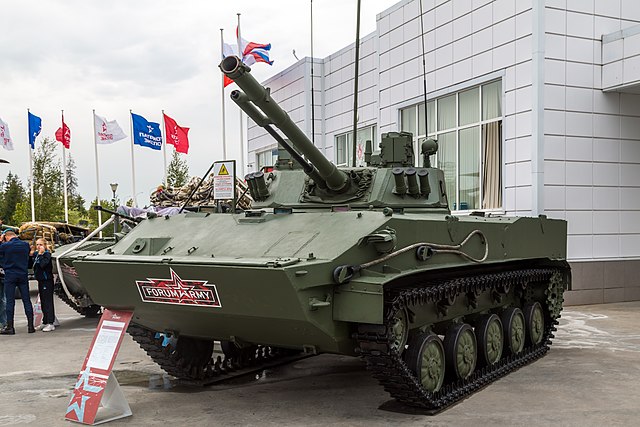
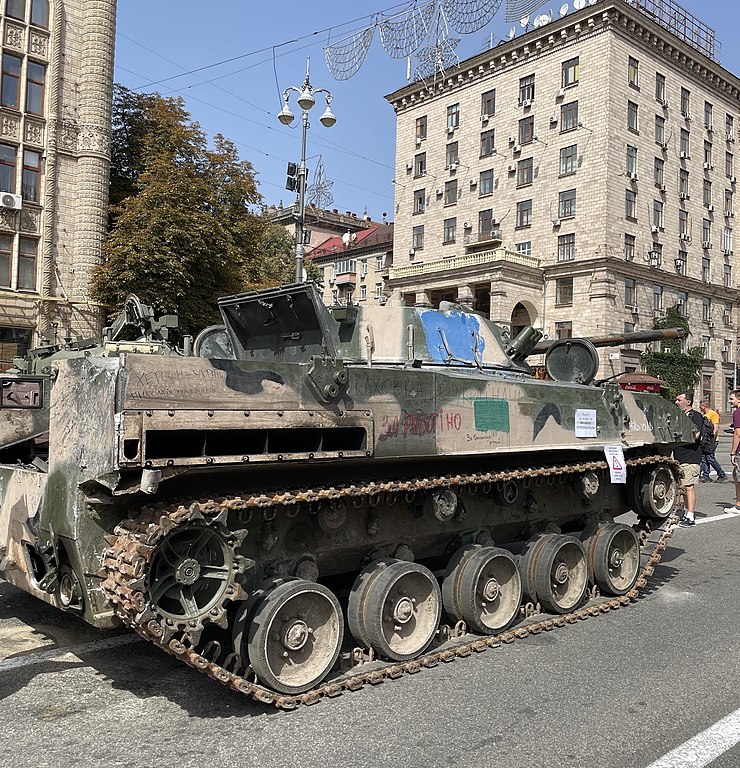
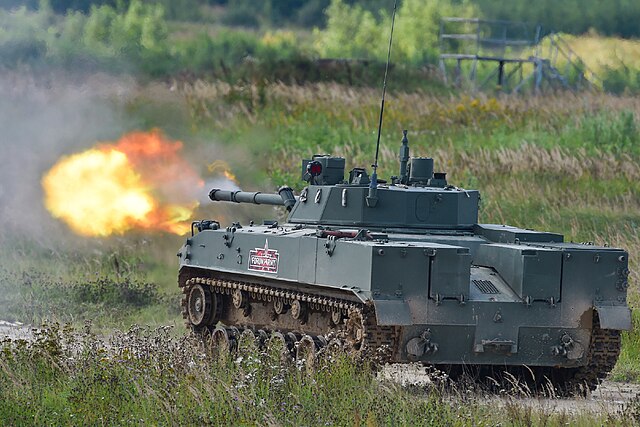
Read More/Src
Links
armyrecognition.com/ bmd-4m picsglobalsecurity.org BMD 4M
armament-for-light-and-hard-armour/bakhcha
bmd-4_bmd-3m_bakhcha_airborne_infantry_combat_armoured_vehicle_technical_data_sheet
globalsecurity.org
armyrecognition.com/
man.fas.org/
oryxspioenkop.com/2022/02/attack-on-europe-documenting-equipment
commons.wikimedia.org
wikipedia.org/wiki/BMD-4
Videos
Model Kits
Trumpeter 4m 1:35
Modern Tanks
Modern MBTs posters

Denel Bagder (2018)

Type 16 MCV (2016)

Gepard 1A2 last rounds 2011

SANDF

Russian AFVs

Main Battle Tanks
